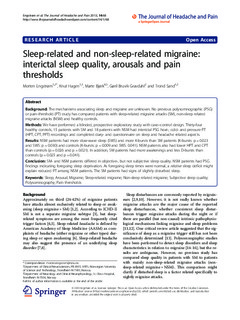| dc.contributor.author | Engstrøm, Morten | |
| dc.contributor.author | Hagen, Knut | |
| dc.contributor.author | Bjørk, Marte Helene | |
| dc.contributor.author | Gravdahl, Gøril Bruvik | |
| dc.contributor.author | Sand, Trond | |
| dc.date.accessioned | 2019-10-29T11:25:52Z | |
| dc.date.available | 2019-10-29T11:25:52Z | |
| dc.date.created | 2013-12-20T11:25:25Z | |
| dc.date.issued | 2013 | |
| dc.identifier.citation | The Journal of Headache and Pain. 2013, 14 (68), . | nb_NO |
| dc.identifier.issn | 1129-2369 | |
| dc.identifier.uri | http://hdl.handle.net/11250/2625090 | |
| dc.description.abstract | Background
The mechanisms associating sleep and migraine are unknown. No previous polysomnographic (PSG) or pain-threshold (PT) study has compared patients with sleep-related migraine attacks (SM), non-sleep related migraine attacks (NSM) and healthy controls.
Methods
We have performed a blinded, prospective exploratory study with case–control design. Thirty-four healthy controls, 15 patients with SM and 18 patients with NSM had interictal PSG heat-, cold- and pressure PT (HPT, CPT, PPT) recordings and completed diary- and questionnaire on sleep and headache related aspects.
Results
NSM patients had more slow-wave sleep (SWS) and more K-bursts than SM patients (K-bursts: p = 0.023 and SWS: p = 0.030) and controls (K-bursts: p = 0.009 and SWS: 0.041). NSM patients also had lower HPT and CPT than controls (p = 0.026 and p = 0.021). In addition, SM patients had more awakenings and less D-bursts than controls (p = 0.025 and p = 0.041).
Conclusion
SM- and NSM patients differed in objective-, but not subjective sleep quality. NSM patients had PSG findings indicating foregoing sleep deprivation. As foregoing sleep times were normal, a relative sleep deficit might explain reduced PT among NSM patients. The SM patients had signs of slightly disturbed sleep. | nb_NO |
| dc.language.iso | eng | nb_NO |
| dc.publisher | BMC (part of Springer Nature) | nb_NO |
| dc.rights | Navngivelse 4.0 Internasjonal | * |
| dc.rights.uri | http://creativecommons.org/licenses/by/4.0/deed.no | * |
| dc.title | Sleep-related and non-sleep-related migraine: interictal sleep quality, arousals and pain thresholds | nb_NO |
| dc.type | Journal article | nb_NO |
| dc.type | Peer reviewed | nb_NO |
| dc.description.version | publishedVersion | nb_NO |
| dc.source.pagenumber | 9 | nb_NO |
| dc.source.volume | 14 | nb_NO |
| dc.source.journal | The Journal of Headache and Pain | nb_NO |
| dc.source.issue | 68 | nb_NO |
| dc.identifier.doi | 10.1186/1129-2377-14-68 | |
| dc.identifier.cristin | 1079986 | |
| dc.description.localcode | © 2013 Engstrøm et al.; licensee Springer. This is an Open Access article distributed under the terms of the Creative Commons Attribution License (http://creativecommons.org/licenses/by/2.0), which permits unrestricted use, distribution, and reproduction in any medium, provided the original work is properly cited. | nb_NO |
| cristin.unitcode | 194,65,30,0 | |
| cristin.unitcode | 1920,16,0,0 | |
| cristin.unitname | Institutt for nevromedisin og bevegelsesvitenskap | |
| cristin.unitname | Nevroklinikken | |
| cristin.ispublished | true | |
| cristin.fulltext | original | |
| cristin.qualitycode | 1 | |

